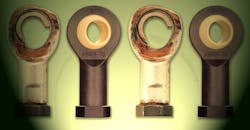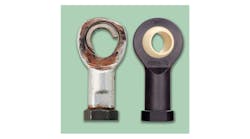Rod-End Bearings—Steel or Plastic?
Spherical rod-end bearings are ideal for supporting rotary and linear motion in a wide variety of applications from packaging and agricultural equipment to medical and exercise machinery. However, choosing between a plastic or steel rod-end bearing often doesn’t happen because many designers are accustomed to going with steel without even considering alternatives. However, plastic and steel rod ends have their own unique set of advantages, disadvantages, and limitations.
Steel and plastic rod-end bearings exhibit different characteristics inherent to their design and materials of construction. Most steel rod-end bearings consist of three parts: a housing, a pivot bearing, and a ball bearing. A plastic rod end, however, contains only two pieces: a housing and a ball.
The configuration of the steel rod-end bearing causes it to rotate with both the shaft and ball against the housing. It compensates for angular misalignment by repositioning the ball relative to the housing. In contrast, in a plastic rod-end bearing, the shaft rotates relative to the ball. Like their steel counterparts, plastic rod ends also compensate for angular deviations by repositioning the ball within the housing. For example, plastic rod ends offered by igus Inc. are designed for rotating and linear applications where the rod end’s spherical ball needs to move slightly to compensate for shaft misalignment.
Head-to-Head Comparison
- Plastic rod-end bearings from certain manufacturers, such as igus, are self-lubricating, meaning no maintenance is required. Metal rod ends, however, need to be meticulously lubricated on a regular basis.
- Plastic rod-end bearings are about half the weight of metal rod ends. This feature can decrease the overall weight and drive force requirements of a system.
- Rod ends made of plastics provide much higher vibration damping when compared to their metal counterparts. The plastic materials themselves are able to absorb vibration forces much more efficiently than steel.
- The lack of external lubricants makes plastic rod ends well suited for both clean and dirty environments. No greases or oils are present to seep out and contaminate sensitive workspaces, and dirt and dust have nothing to stick to on the bearing surfaces, which could otherwise reduce life.
- Plastic bearing materials are extremely resistant to corrosion from water, chemicals, salt, UV rays, and more. This type of exposure, even for short periods of time, can be catastrophic to metal bearings, which can quickly rust or otherwise become damaged.
- Plastic rod-end bearings can be used for all types of motion, including rotating, oscillating, and linear.
On the other hand:
- Plastic rod-end bearings have lower static load capacities than metal options ones. When high forces are present, rod ends made of steel or metals may be necessary.
- When compared to metal, plastic offers a lower tightening torque—too much will crack the plastic.
- A metal sleeve is required when fixing the ball with a screw to keep the screw or bolt from damaging the plastic ball.
- Because plastic does not dissipate heat as efficiently as metals do, when plastic-on-plastic friction occurs, higher heat buildup is possible than with lubricated metal spherical bearings.
- Plastic bearings have a higher tolerance (E10) when compared to steel at, H7.
This discussion was provided by igus Inc., East Providence, R.I.



